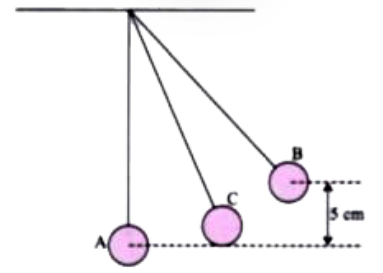Two metallic blocks P and Q having masses in ratio 2 : 1 are supplied with the same amount of heat. If their temperatures rise by same degree, compare their specific heat capacities.
Step by step video solution for Two metallic blocks P and Q having masses in ratio 2 : 1 are supplied with the same amount of heat. If their temperatures rise by same degree, compare their specific heat capacities. by Physics experts to help you in doubts & scoring excellent marks in Class 10 exams.
Updated on:21/07/2023Topper's Solved these Questions
Similar Questions
The figure below shows a simple pendulum of mass 200 g. It is displaced from the mean position A to the extreme position B. The potential energy at the position A is zero. At the position B the pendulum bob is raised by 5 m.

(i) What is the potential energy of the pendulum at the position B?
(ii) What is the total mechanical energy at point C?
(iii) What is the speed of the bob at the position A when released from B ?
(Take g = 10ms−2 and there is no loss of energy.)
View SolutionChoose the correct statement with respect to critical angle
View SolutionShow that the sum of kinetic energy and potential energy (ie, total mechanical energy) is always conserved in the case of a freely falling body under gravity (with air resistance neglected from a height by finding it when (i) the body is at the top c) the body has fallen a distance in the body has reached the ground.
View SolutionThree different substances have the specific heats in the ratio 1:2:3 and the temperature increases in the ratio 3:2:1 when the same heat is supplied to the three substances. The ratio of their masses is
View SolutionTwo spheres of radii in the ratio 1:2 and densities in the ratio 2:1 and of same specific heat, are heated to same temperature and left in the same surronding. There are of cooling will be in the ratio
View SolutionThe amount of heat absorbed by a body while raising its temperature is given by the equation. Q = mstheta , here Q is the amount of heat, m is the mass of the body, s is the specific heat capacity and theta is the rise tmemperature. Dertermine the S.I. unit and C.G.S. unit of heat and specific heat capacity
View SolutionTwo cylinderical bodies 'A' and 'B' have their radii in the ratio of 1:2 and their lengths are in the ratio of 3:2. When equal amount of heat energy is supplied to them, the rise in the temperature of A is found to be double the rise in temperature of B. Determine the ratio of their specific heat capacity. The ratio of density of A and B is 3:1
View SolutionTwo spheres of the same metal have radii in the_ratio 1 : 2 Their heat capacities are in what ratio
View Solutionदो धातुओं के घनत्व का अनुपात 1 : 3 हैं।इनके समान आयतनो को समान ऊष्मा देने पर उनके ताप में वृद्धि का अनुपात 2 : 1 है। इनकी विशिष्ट ऊष्माओं का अनुपात होगा :
View SolutionTwo metalic spheres p and Q are made of same material have same smoothness but the weight of p is 8 times that of Q if the two are heated to same temperature and left to cool then the ratio of rate of cooling of Q to that of p is
View SolutionTwo spheres whose ratio in radius and density respectively 1:2 And 2:1 Is, and specific heat is the same. Both the balls are heated to the same temperature and left in the same environment, the ratio of the rate of loss of heat in both the balls will be
View SolutionTwo lead spheres at the same temperature have radii in the ratio 1 :2. What is the ratio of their heat capacities?
View SolutionAll solids expand by the same amount when heated to the same rise in temperature.
View SolutionTwo metallic blocks P and Q having masses in ratio 2 : 1 are supplied with the same amount of heat. If their temperatures rise by same degree, compare their specific heat capacities.
View SolutionTwo bodies A and B of equal masses are supplied with equal amount of heat energy. If rise in temperature of A is more than that in B, what is the relation between their specific heats?
View SolutionTwo cylinderical bodies 'A' and 'B' have their radii in the ratio of 1:2 and their lengths are in the ratio of 3:2. When equal amount of heat energy is supplied to them, the rise in the temperature of A is found to be double the rise in temperature of B. Determine the ratio of their specific heat capacity. The ratio of density of A and B is 3:1
View Solution